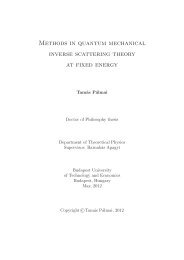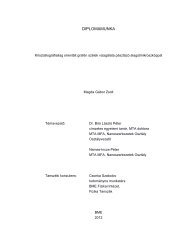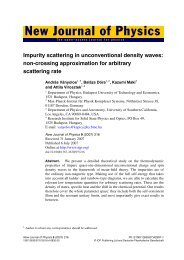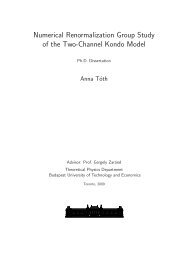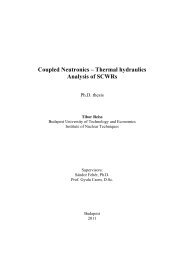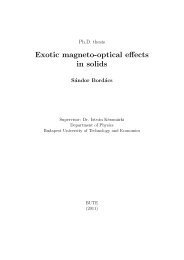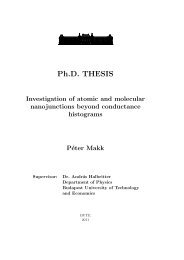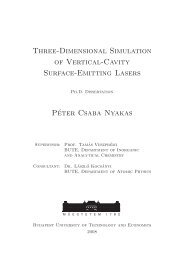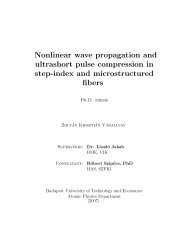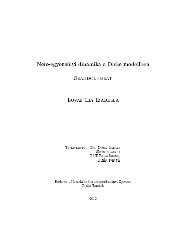Ph.D. THESIS Multipolar ordering in f-electron systems
Ph.D. THESIS Multipolar ordering in f-electron systems
Ph.D. THESIS Multipolar ordering in f-electron systems
You also want an ePaper? Increase the reach of your titles
YUMPU automatically turns print PDFs into web optimized ePapers that Google loves.
Chapter 2 Overview of the Theoretical Background 9<br />
trostatic potential V can be expressed <strong>in</strong> terms of the spherical harmonics,<br />
V (r) =<br />
∞∑<br />
k∑<br />
k=0 q=−k<br />
a q k rk Y q<br />
k (θ, φ) . (2.2)<br />
For example, for a tetragonal environment, the lowest order term is quadratic,<br />
and this is followed by a series of higher-order terms<br />
V tetr (r) = C 1 (3z 2 − r 2 ) + C 2 (x 4 + y 4 + z 4 − 6r 4 ) + ... (2.3)<br />
where r 2 = x 2 + y 2 + z 2 .<br />
2.2.1 Stevens Equivalents<br />
V tetr (r) appear<strong>in</strong>g <strong>in</strong> (2.3) should be put <strong>in</strong>to the Schröd<strong>in</strong>ger equation as a<br />
one-<strong>electron</strong> potential. However, we do not wish to solve the problem <strong>in</strong> full<br />
generality. Our ma<strong>in</strong> <strong>in</strong>terest is <strong>in</strong> f-<strong>electron</strong> <strong>systems</strong> for which the relevant<br />
subspace is the (2J + 1)-dimensional J-eigenspace. It can be shown that<br />
with<strong>in</strong> this Hilbert space, V tetr acts like<br />
V tetr (r) → c ′ 1[3J 2 z − J(J + 1)] + c ′ 2[O 0 4 + 5O 4 4] + ... (2.4)<br />
where the second term conta<strong>in</strong>s a complicated fourth order polynomial of J x ,<br />
J y , J z (see Appendix A). Our po<strong>in</strong>t is the correspondence of the first term<br />
to the first term of (2.3).<br />
The general lesson is that for our purposes, operators expressed <strong>in</strong> terms of<br />
the cartesian coord<strong>in</strong>ates x, y, z can be replaced by equivalent expressions of<br />
J x , J y , J z . However, to account for the fact that J x , J y , J z do not commute<br />
while x, y, z do, we always have to symmetrize the J components. The<br />
simplest example is<br />
xy → J x J y = (J x J y + J y J x ) (2.5)<br />
which happens to be the quadrupolar moment O xy . Here, and <strong>in</strong> the follow<strong>in</strong>g,<br />
”overl<strong>in</strong>e” means symmetrization.<br />
O xy is the Stevens equivalent of xy. Similarly, (2.4) is the Stevens<br />
equivalent of (2.3). It is a general consequence of the Wigner–Eckart theorem<br />
that Stevens replacements act equivalently to the orig<strong>in</strong>al operators<br />
with<strong>in</strong> a J-eigenspace. Introduc<strong>in</strong>g Stevens equivalents makes us<strong>in</strong>g a (J, J z )<br />
basis very convenient. This is what we will usually do. We will use the<br />
Stevens equivalents of multipolar moments, and their <strong>in</strong>tersite <strong>in</strong>teractions,<br />
and diagonalize them <strong>in</strong> either s<strong>in</strong>gle-site, or many-site (J, J z ) Hilbert spaces.



